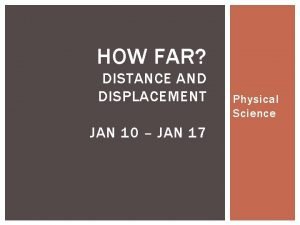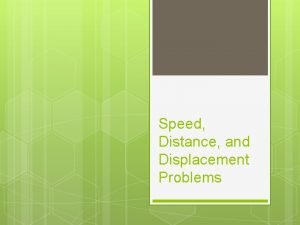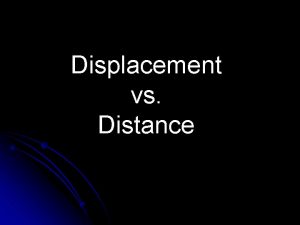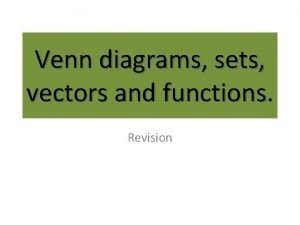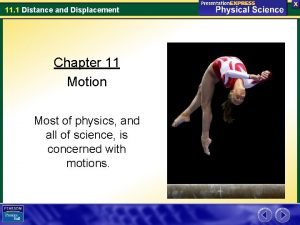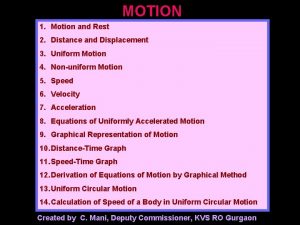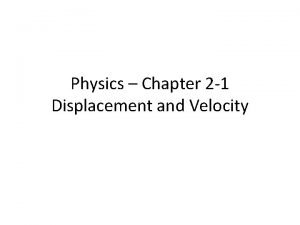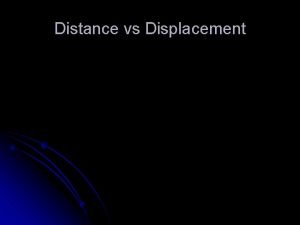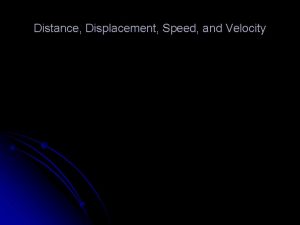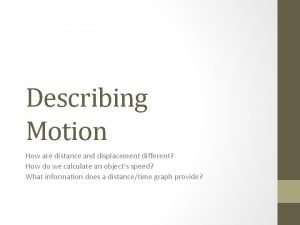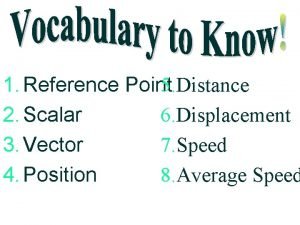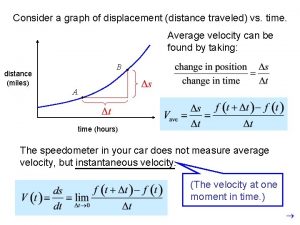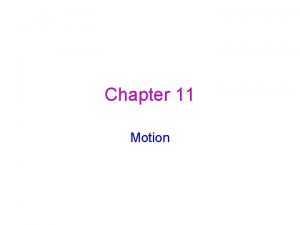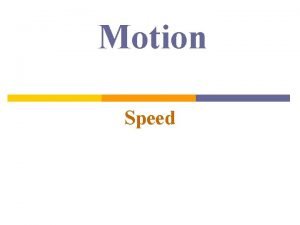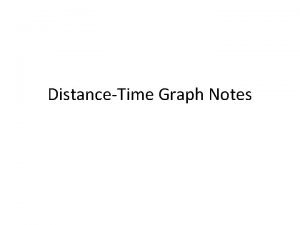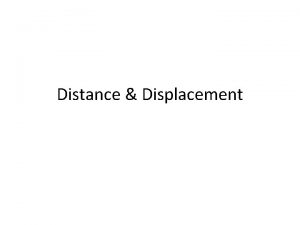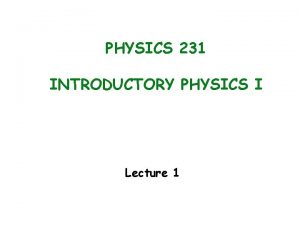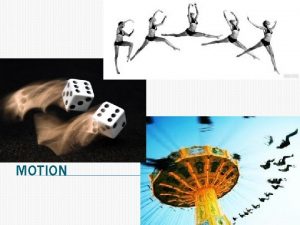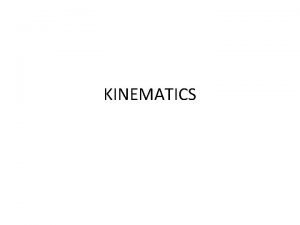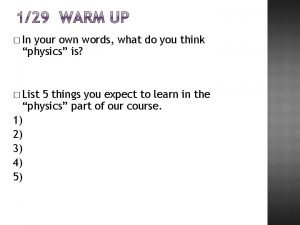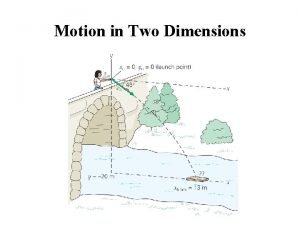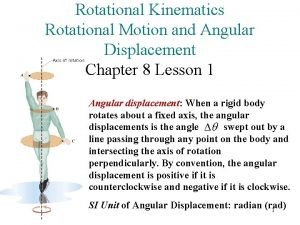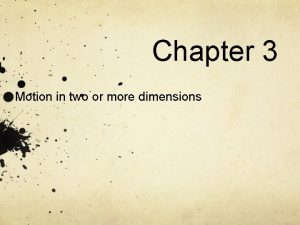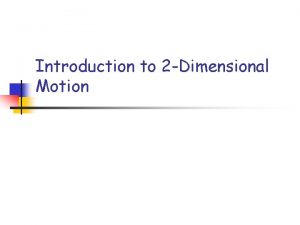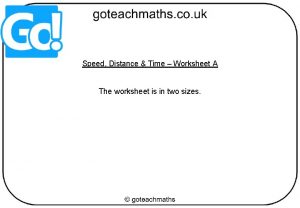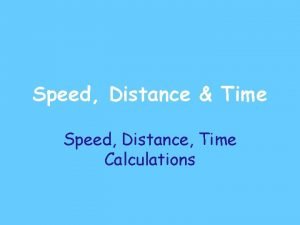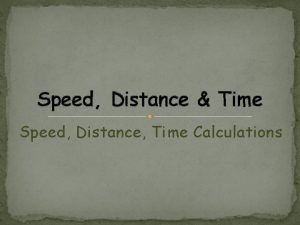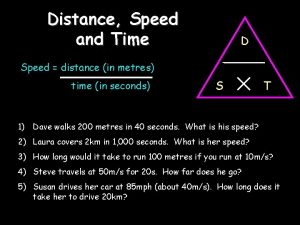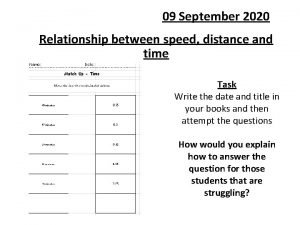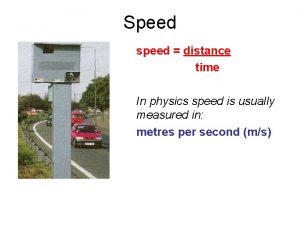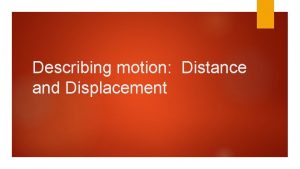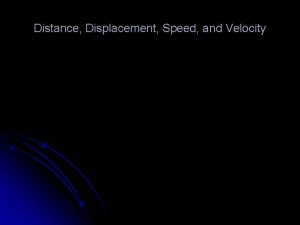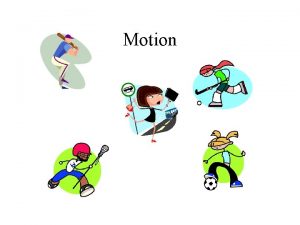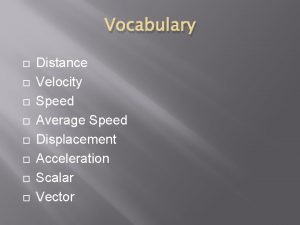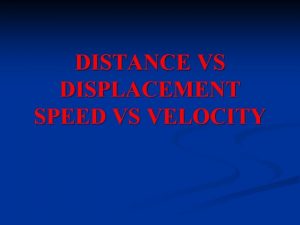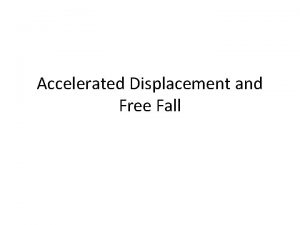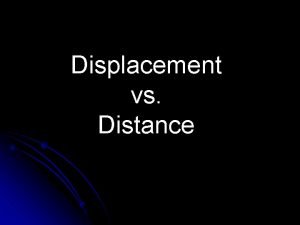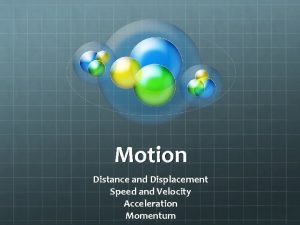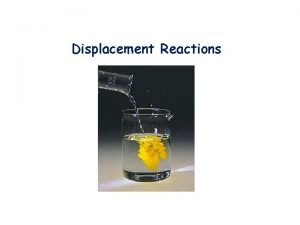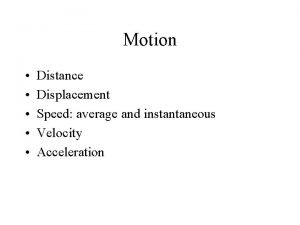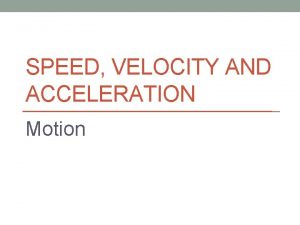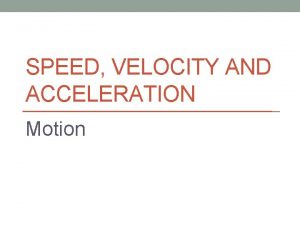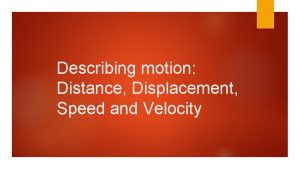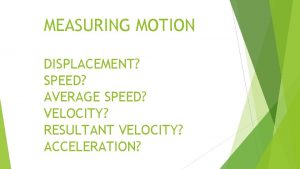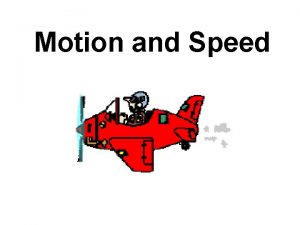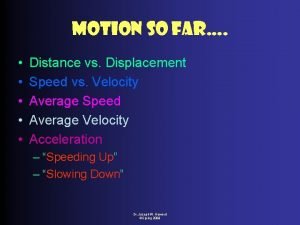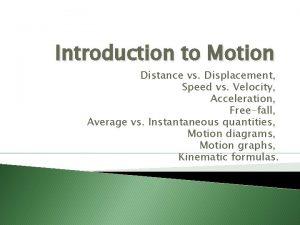One Dimensional Motion Distance and Displacement Speed and








































- Slides: 40

One Dimensional Motion Distance and Displacement Speed and Velocity Graphing Speed/Velocity Acceleration Free Fall

Question of the Day… Match each unit on the right with the type of measurement with which it would most likely be used. 1. Diameter of a Hydrogen atom 2. Distance from the Sun to Earth 3. Wavelength of a photon of visible light 4. Distance from our sun to the nearest star 5. Diameter of a red blood cell a. Light-year b. nanometer c. angstrom d. micron e. Astronomical unit

The Answers…. . n 1. C n 2. E n 3. B n 4. A n 5. D

Choosing a Frame of Reference Before describing the motion of an object, you need to have a frame of reference. A frame of reference is a system of objects that are not moving relative (compared) to one another. The earth is a common frame of reference.

Motion is the change in the position of an object. When this change is compared to another object, it is called relative motion. The reference object can be either at rest or in motion. Linear motion is motion in a straight line.

Measuring Distance n n n Distance is the length of a path between two points. When an object moves in a straight line, the distance is the length of the line connecting the object’s starting and ending points. Example: Walk 5 meters, then walk 10 meters.

Measuring Displacements n n Displacement is the direction from the starting point and the length of the straight line from the starting point to the ending point. Displacement is distance with a specific direction. Example: Walk 5 miles north, then walk 10 miles southeast. See an example of distance vs. displacement

Distance vs. Displacement

Combining Displacements n n n Displacements are added using vectors. A vector is a measurement that has a magnitude (number) and a direction. When two things occur in the same direction, the vectors add. When they act in opposite directions, they subtract. When added (or subtracted), the sum (or difference) is called the resultant vector.

Combining Displacements Start 5 m Return to Home Page 7 m 10 m

Question of the day…Quiz (10 pts) Please place all answers on a separate sheet of paper. 1. A student walks 3 blocks from his home to school, walks home for lunch, and then returns to school. What is (a) the total distance he walked, and (b) his overall displacement. 2. To get to a friends house, you make the following trip: 5 blocks north, 7 blocks west, and 5 blocks south. (A) What distance did you travel? (B) how far away is your friends’ house? …include distance AND direction!

Speed can be defined in a couple of ways: How fast something is moving The distance covered in a certain amount of time The rate of change of the position of an object Units for speed are: This is the standard unit miles / hour (mi/hr) kilometers / hour (km/hr) feet / second (ft/s) meters / second (m/s)

Average and Instantaneous Speed Average Speed = total distance covered time to travel that distance Instantaneous Speed is the speed at any instant in time.

During a typical trip to school, your car will undergo a series of changes in its speed. If you were to inspect the speedometer readings at regular intervals, you would notice that it changes often. The speedometer of a car reveals information about the instantaneous speed of your car; that is, it shows your speed at a particular instant in time.

For each use of velocity described below, identify whether it is instantaneous velocity or average velocity. 1. 2. 3. 4. The speedometer on your car indicates you are going 65 mph A race-car driver was listed as driving 120 mph for the entire race. A freely falling object has a speed of 19. 6 m/s after 2 seconds of fall in a vacuum. The speed limit sign says 45 mph.

Calculating Speed

d V t

Example Sound travels at a speed of 330 m/s. If a firecracker explodes 3630 m away from you, how long does it take for the sound of the explosion to reach you? Speed, v = 330 m/s distance, d = 3630 m time, t = ? So it takes 11 seconds for the sound of the explosion to reach you.

Velocity is speed in a particular direction. – 60 m/s north Constant Velocity does not change in speed or direction. Changing velocity can be a change in speed, direction, or both. Whenever there is a change in the velocity of an object, that object is said to be accelerating.

Question of the Day…Velocity Quiz 1. 2. If you are driving at 25 m/s and look out the window for 2. 5 seconds, what distance have you traveled while looking out the window? (4 pts) To get from the gym to class, you walk a distance of 135 meters. If you walk at a speed of. 65 m/s, will you get to class in 4 minutes? (6 pts)

Graphing Speed or Velocity When constructing a graph of speed or velocity, distance is plotted on the vertical, or y-axis, and time is plotted on the horizontal, or x-axis. The speed of an object can be found from the graph by calculating the slope of the line.

Constant Speed Graph A distance-time graph for constant speed is a straight line. How far did the person walk in 11 seconds? What is her average speed? What is her instantaneous speed at 8 seconds?


Variable Speed Graph How far did the person walk in 5 seconds? What is her average speed? What is her instantaneous speed at 5. 5 seconds? At 7 seconds? When is she walking faster from 0 -4 seconds or from 6 -8 seconds?

Return to Home Page

Question of the Day…. Quiz (10 pts) 1. 2. A car travels 1200 m in 2 minutes. What is its average velocity in m/s? (3 pts) A sprinter runs 10 m in 30 seconds, then speeds up to 1 m/s for 1 minute. a) What is her average speed for the whole trip? (2 pts) b) What is her instantaneous speed at 45 sec? (2 pts) c) Make a distance vs. time graph for this example (3 pts)

Question of the Day…Acceleration Write each of the following in your notebook. Circle each situation described below in which the object has an acceleration. For each one you circle, identify the direction in which the acceleration is acting. 1. 2. 3. 4. 5. A car moves to the right while slowing down. A marble moves in a circular path inside a paper plate at a constant speed. The moon orbits the Earth. An air hockey puck moves smoothly across the air hockey table after being struck. A rocket is launched upward from the launch pad.

Answers…. 1. 2. 3. 4. 5. yes, this is deceleration. Yes, this is centripetal acceleration Yes, also centripetal acceleration No, this is constant velocity Yes, this is acceleration

Acceleration is the rate at which velocity changes. Any time velocity changes, an object is undergoing an acceleration. A decrease in velocity is called deceleration. This change can be by speeding up, slowing down, or changing direction.

Acceleration Units of acceleration are: This is the standard unit (miles / hour) / second (kilometers / hour) / second (feet / second) / second (meters / second) / second mph/s kmh/s ft/s 2 m/s 2 Acceleration along the ground is horizontal acceleration. Vertical acceleration is called “free fall”.

Calculating Acceleration

Example A car’s velocity at the top of a hill is 10 m/s. Two seconds later it reaches the bottom of the hill with a velocity of 26 m/s. What is the acceleration of the car? The car is increasing its velocity by 8 m/s for every second it is moving.

Graphing Acceleration A velocity vs. time graph is used to find acceleration. What is the final velocity of the car? What is the instantaneous velocity of the car at 3 seconds? What is the acceleration of the car? Return to Home Page



Free Fall The acceleration of a falling object is due to the force of gravity between the object and the earth. Galileo showed that falling objects accelerate equally, neglecting air resistance. On the surface of the earth, in a vacuum, all objects accelerate towards the surface of the earth at 9. 8 m/s 2. This value is called “g”.

Effect of Gravity on an Object

Without Air resistance With Air resistance

Gravity and an Accelerating Object Since the acceleration of gravity is 9. 8 m/s 2, an object increases (or decreases) its velocity by 9. 8 m/s each second. What is the speed of the object after 3 seconds? After 5 seconds? What is the acceleration of the dropped object after 2 seconds? After 6 seconds? How would this graph change if the object were thrown up into the air?

Question of the Day…Quiz (10 pts) Complete the table below by drawing arrows to indicate the directions of the object’s velocity and acceleration (remember it’s not always up and down). Description of Motion A ball is dropped from a ladder. A car is moving to the right when the driver applies the brakes to slow down. A ball is tied to a string and being swung clockwise is at the top of its circular path. A sled is pushed to the left causing it to speed up. Direction of Velocity Direction of Acceleration
 Circular motion is one dimensional or two dimensional
Circular motion is one dimensional or two dimensional What is the difference of distance and displacement
What is the difference of distance and displacement How to find time with distance and speed
How to find time with distance and speed What is fringe vision when driving
What is fringe vision when driving Single displacement vs double displacement
Single displacement vs double displacement Dimensional displacement
Dimensional displacement Distance and displacement problems
Distance and displacement problems Distance and displacement
Distance and displacement Distance and displacement venn diagram
Distance and displacement venn diagram Chapter 11 distance and displacement
Chapter 11 distance and displacement Graphical representation of motion
Graphical representation of motion Distance and displacement examples
Distance and displacement examples Two students walk in the same direction
Two students walk in the same direction Distance vs. displacement
Distance vs. displacement Distance vs displacement
Distance vs displacement How is distance different from displacement
How is distance different from displacement Is distance a scalar quantity
Is distance a scalar quantity Displacement is distance combined with
Displacement is distance combined with Displacement vs distance traveled
Displacement vs distance traveled Displacement is distance combined with
Displacement is distance combined with Distance vs displacement
Distance vs displacement Distancetime graph
Distancetime graph Distance is a scalar
Distance is a scalar Distance vs. displacement
Distance vs. displacement Distance vs. displacement
Distance vs. displacement Distance vs displacement
Distance vs displacement Reverse image search google
Reverse image search google Sin 37°
Sin 37° Displacement formula projectile motion
Displacement formula projectile motion Si unit of angular velocity
Si unit of angular velocity Two dimensional motion
Two dimensional motion Two dimensional motion definition
Two dimensional motion definition Average 400 meter time
Average 400 meter time How to calculate speed with time and distance
How to calculate speed with time and distance Speed time distance worksheet
Speed time distance worksheet Speed distance and time
Speed distance and time Distance time speed formula
Distance time speed formula Speed distance time revision
Speed distance time revision Distance is speed over time
Distance is speed over time Relationship between speed and time
Relationship between speed and time Distance is speed over time
Distance is speed over time

